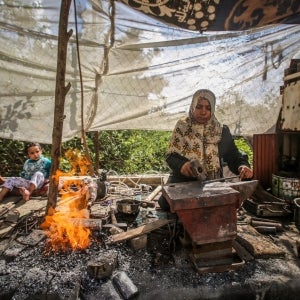Since October 2023, the human suffering in Gaza has been immense: an estimated 75% of the population has been displaced, with more than 60% of physical infrastructure destroyed and daily life a struggle for survival.
Amid the devastation, financial service providers in the West Bank and Gaza are grappling with unprecedented challenges in a dynamic, ever-changing crisis. The impacts on the West Bank are not the same as on Gaza, and Gaza today faces different challenges compared to even March or January of this year.
The role of financial tools to offer resilience seems ever dimmer as the conflict draws on. And yet, we know that when stability does return, large amounts of development assistance are likely to flow, lasting for years, and channeled partly through the financial sector. Supporting the financial sector in the West Bank and rebuilding it in Gaza will be critical groundwork for allowing this investment to flow.
Challenges of providing financial services in acute, multi-dimensional crises
For financial service providers operating in the West Bank and Gaza, business disruptions are nothing new. In September of 2023, many had contingency plans informed by past crises – USSD for when mobile data services are unavailable, solar-powered ATMs for when power is cut, and adapted procedures for client check-ins, including using these visits for referrals to relief organizations.
In the West Bank, such scripts from past crises have remained relevant today. An economic slowdown has forced many businesses to scale back or shut down – the result of mobility restrictions and revoked Israeli work permits for Palestinian workers (estimated at 190,000 pre-crisis). Credit and repayment risk have deepened with the loss of income, yet leading institutions have managed to activate response plans geared toward managing their portfolios.
In Gaza, the situation is obviously very different from past crises. Initially, some financial institutions operating in Gaza were able to keep systems running from the West Bank. Even at a time when many of their staff were unaccounted for and customers unreachable, institutions such as The Bank of Palestine and Al-Quds Bank reported organizing high-risk operations to move millions of U.S. dollars in cash from half-destroyed branches in the North to Southern Gaza, where demand became concentrated.
In the early stages of the conflict, financial services appeared to act as a tool of limited resilience:
- Savings helped protect financial assets. Although only a minority of Palestinians held accounts before the crisis (around 34% of adults, 26% of women, in the West Bank and Gaza), these accounts were actively used. In the first month of the war, an estimated 20 million USD were deposited at bank branches, with individuals preferring to trust banks rather than risk losing the cash kept at home with the destruction of their property.
- Remittances helped maintain a link to the world. While international money transfer operators like Western Union and Money Gram were inactive since early on in the conflict, exchange agents continued to offer remittance services, partly relying on Egyptian telecommunication networks and informal arrangements, echoing findings from the early days of the crisis in Sudan.
- Some cash transfers continued to reach recipients, though through limited access points. The Bank of Palestine and its wallet provider had the largest networks in Gaza before the conflict and they continued running, enabling customers to use online banking, wallet, and over-the-counter services in the moments when both electricity and power were available. Even following the onset of the crisis, agents were able to facilitate the transfer of 47 million USD of humanitarian aid to 1.2 million people, despite only 10-20% of agents continuing operation.
Yet as the conflict has dragged on, the points of hope have become fewer, showing the limits of financial tools to provide resilience. Large microfinance institutions such as Vitas and Faten have deemed the Gaza portfolio a loss. An upside-down, wartime economy has replaced the previous one. Cash transfer volumes have declined, with the focus now on meeting the immediate needs of food and shelter, where this is possible at all.
This blog is missing a conclusion
This blog is missing a conclusion because we don’t yet know where things will end. A political settlement is the only meaningful way to end the war – and peace is a prerequisite to imagining a future for the financial sector.
Looking ahead, it is obvious that financial services will have a role to play. In supporting the immediate need for cash assistance, when a working economy exists. In supporting the graduation of the poorest out of poverty, when sufficient stability exists to enable those livelihoods. And in supporting small business development, when there is once again hope enough to seize those opportunities.
The reconstruction of a robust and inclusive financial sector in the West Bank and Gaza will be essential for enabling those investments. But the job ahead will be immense and it will be critical that the development community focuses and coordinates their efforts.
To do so, funders can learn from the financial sector reconstruction in other post-conflict settings. Three immediate lessons stand out from CGAP’s work on inclusive finance in fragile countries:
- Avoid duplicating efforts by coordinating investment through strategic platforms (e.g. 3RF in Lebanon, I3RF in Iraq)
- Support the recovery of financial institutions rather than starting again, to help the private sector recover more quickly and efficiently
- Invest in building strong local support institutions (e.g., MISFA Afghanistan) with the potential to drive sustainable market support and coordination into the future.



